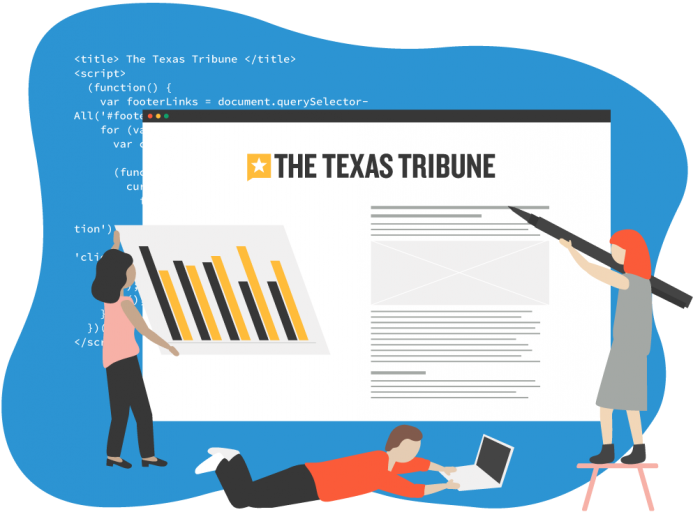
Sponsored content? Disguising advertisements as your hard-reported journalism? Fooling readers into clicking on some corporate story? What is this tomfoolery?
That might’ve been the typical gut reaction a few years ago, when the lines between the editorial and business sides drew closer as newsrooms became smaller and smaller. But when done properly, sponsored content can be a (clearly designated) supplement to a site’s journalism that also brings in revenue to make the journalism happen.
That’s one lesson learned over the years by The Texas Tribune, arguably the most successful local or regional nonprofit news organization in the country. (It celebrated its 10th birthday yesterday; here’s our story from the launch in 2009.) Six years ago, The Texas Tribune made a gamble with sponsored content — putting it on a separate site. It outsourced its contributed opinion pieces and corporate paid posts to TribTalk.org, the sister site of the main URL and run under a different CMS. Executive editor Ross Ramsey personally selected which contributed pieces would run, and the sales team under chief revenue officer April Hinkle corralled the client-created sponsored content posts as well. But coming off a months-long process with the Local Media Association’s branded-content project, the sole nonprofit news outlet in the cohort is revamping that strategy by bringing it onto the home website.“The whole idea was to give these posts greater visibility,” Hinkle said. “The transition for us is really moving from an area that was set for thought leadership from individuals and organizations and transitioning it and presenting it with award-winning Texas Tribune content.”
This means that TribTalk is no longer.
“We started this secondary site to focus on user-generated opinion pieces, and it was a good opportunity to say, ‘This is not our editorial content,'” Rodney Gibbs, chief product officer, said earlier this summer as testing for the branded content project got underway. “It was a good sandbox to see if there’s a market for these sponsored content pieces, to see how we’d treat them in a design and workflow way, to see if there’s an appetite for people who would pay for it. Now, several years later, we realize we answered all those affirmatively.”
TribTalk operated on a separate CMS, which didn’t allow for much rich content besides text and photos. Clients will now be able to use the full suite of TexasTribune.org’s CMS abilities — heck, they could even embed a podcast if they desire, Gibbs said. But the team is careful to clearly label the sponsorship as such after four rounds of user testing to figure out what signage was most effective.
An example from its homepage:

And from its daily newsletter The Brief (the Tribune didn’t previously promote sponsored content, and the sponsored URLs are still unsearchable — a landing page for all paid posts is in the works):

And on the paid post itself (you have to click the blue “What is a paid post?” to expand the explanation, but it’s repeated in full at the bottom of the post with no click needed — if you scroll that far):

(That “posted by” part doesn’t literally mean the client went into the CMS and hit publish, for the record, Gibbs said.) Nieman Lab described TribTalk’s sponsored content goals at its outset in 2013:
At that time, a paid post was running $2,500 for one item of sponsored content on the TribTalk homepage for three days. More recently, one slice of sponsored content has set an advertiser back $2,750 (and they produce the content themselves). At that price, TribTalk brought in 80 posts during the five months of the most recent legislative session, with one third of customers buying multiple posts. That accounts for 10 percent of the Tribune’s digital advertising revenue, Hinkle said.As an exercise in sponsored content, what that means is the Tribune might see submissions from organizations like the Beer Alliance of Texas, AT&T, or Texans for Education Reform. But the goal is to round out the site with unpaid submissions from readers, officials, and others, [editor-in-chief Emily] Ramshaw said, and they’ve already reached out to 200 experts and other thinkers around the state to ask if they would be interested in contributing. There’s an audience of people who want to be involved with the Tribune, or use the Tribune as venue for ideas, she said. The site’s events business is one example of that, Ramshaw said. “People want to engage in person and online. They want a bigger platform and forum to do it,” she said.
In addition to the extra CMS lift, TribTalk suffered the way many sibling sites do — it wasn’t getting that much traffic, its social accounts were relatively quiet, and it was hard to shift staffers’ attention away from the main site. “In the last five years, TribTalk never garnered the same type of interest — the same traffic, the same social shares — our destination news site gets. And it never had the same devotees — the engaged audience that makes our live events and our comment threads and our member community so robust,” Ramshaw wrote in a note to readers on the Tribune’s website last week. “For those reasons, we’re closing its doors.”
How can readers who don’t have a few grand to spend get their voices heard? TribTalk’s closure means the end of the op-ed submission style for the Tribune. Ramshaw encouraged readers that “we’ll still share your perspectives and voices, you’ll just find them within our news stories and our videos and our podcasts. We’ll still ask the questions you want answered, during live events, in our This Is Your Texas Facebook group, and by way of our Texplainer series.” That’s not quite the same as a government official laying out their stance or a reader with a stake in a particular matter getting to share their thoughts, but opinion journalism — just like sponsored content — is getting a fresh look in the industry now, too.
And hey, there’s always Medium.